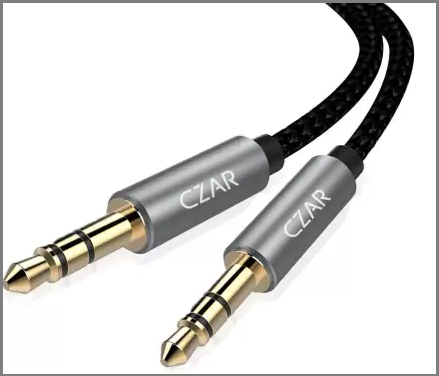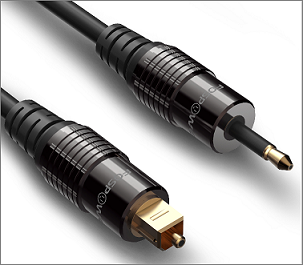The main difference between them is that AUX is analog while optical is digital input. Therefore, their way of working is different from one another. In this article, we will discuss in detail about AUX and optical input, their differences, their strengths and weaknesses and which one you should choose.
What Is AUX Input?
AUX enables the input of audio signals from various devices like MP3 players, speakers, headphones, and portable music players. Also called the AUXiliary port, it is a standard communication port where signals are transmitted through the AUX cable. AUX is also accessible for PC and lets you configure it with different types of common audio devices. It is universal for audio and is in the form of a single jack. AUX inputs are found in active loudspeakers, stereo receivers, and automobile stereo systems. With an AUX input in the car stereo, you will be able to connect plenty of devices like smartphones and MP3 players.
What Is Optical Input?
Optical input has been in use since the 1980s. It enables transmitting audio data digitally with an optical audio cable. Over time, optical input has seen a lot of modifications. Despite this, it has not been fully exploited. In high-end soundbars, the port labeling is “Digital Audio-in” or “Optical Audio”. By using fiber optic cables as well as laser light, devices can transmit audio signals. The optical input is slowly gaining popularity due to various high res audio formats. It can even support uncompressed PCM audio on more than two channels.
AUX Vs Optical – The Sound Quality
The major difference between AUX and optical sound quality is that AUX is analog and optical cable is digital. AUX cable can carry analog signals through the source device. However, analog signals are liable to interference when compared to digital signals. When there is any interference, we can hear popping or hissing noises. In this regard, we can say that optical cable can provide enhanced sound. Also, AUX cables have copper construction and they can only transmit sound through the analog medium. Even data transmitted is in a continuous waveform. Optical audio on the other hand uses laser light for digital information transmission. It uses a hollow fiber optic cable and can transmit more information compared to the RCA/AUX cable. The optical cable can send surround digital signal and the AUX connector can carry two-channel analog audio.
Pros And Cons Of AUX Vs Optical Input
Here is a comprehensive look at the pros and cons of AUX and optical input for home audio systems.
Advantages of AUX Inputs
One of the greatest benefits of AUX input is that it comes with maximum compatibility. Whether you use an iPhone, Android phone, or a Walkman, you will be able to connect it with your home stereo. AUX input works with almost all types of audio devices. Another great advantage is that it comes with plug and play function and you will only have to plug it into the device. In addition to this, AUX input is also available at an affordable value. AUX cables can also provide excellent signal separation. Even over long distances, they can provide better audio quality.
Disadvantages of AUX Input
While using the AUXiliary input, you will have to note that the music player or phone does the major work. It is the phone hardware that processes the files and transmits them through the 3.5mm jack. AUX cable is also prone to line loss. Additionally, AUX cables can lead to audio distortion. Keep in mind that most portable devices don’t come with line-level outputs. It can lead to additional noise on the audio signal which can easily pass through AUX jacks. Processing surround sound with AUX will require multiple AUX cables which can be very messy.
Advantages of Optical Input
When compared to AUX, Optical input has many benefits. With optical input, there will be high-resolution audio signals in up to 7.1 channels. Even though there is not much difference in the audio quality, it is supported by most modern home theaters. When you use optical input with a surround sound system, the result is better than AUX input. It does not require any complex wiring so that the audio quality will not be compromised.
Disadvantages Of Optical Input
Long cable runs can make optical input lose data. It primarily happens when the binary “1”s and “0”s don’t arrive on time. This can lead to blank portions in the audio. In this regard, an AUX cable can be great for long cables.
Which One To Choose For Better Audio Clarity?
Many factors determine whether you should go for AUX or Optical Input. An optical line can provide you with better channel separation, clear sound, and high spatial quality. It all boils down to how good the speakers are and the length of the cable. You may not be able to detect the difference. If in case your device supports both AUX and optical input, you can plug in both. There will not be any significant difference. As we have said that AUX is susceptible to line loss and interference, you may not get clear sound performance. On the contrary, an optical connection can provide better channel separation and superior spatial quality. Keep in mind that it is the speakers that actually determine the audio performance. Additionally, it is also the cable length, hearing ability, and the source device which really matters.
Is AUX Input Better For Soundbar?
The analog connection method or AUX-in is supported by most soundbars and television. All you have to do is use a standard RCA cable for transmitting the analog signal. When you keep the cord far from the power source, it will be less susceptible to interference. Furthermore, you will also have to use the settings of the television for disabling the speakers. You must only use the Sound Bar volume control.
Step To Connect Your Soundbar to Your TV With Optical Cable –
By following these steps, you will be able to improve the sound quality on the television.
Remove any safety caps that are installed at the ends of the optical cable. In doing so, it will connect to the ports. The next thing will be to locate the ports on the television. Look for a ‘Digital Audio Out’ and plug in the optical cable. Follow by plugging the second end in the soundbar’s Digital Audio-In port. You will have to make sure that data flows from the television to the soundbar for producing sound by connecting the optical output port to the optical in. The next step will be to turn on the power of the soundbar as well as the television. Now you can use the remote control of the soundbar for source button and choose digital IN. You will now see the “D-IN” display on the soundbar’s front panel. This indicates that your connection is ready.
Conclusion
AUX and optical input are two different things. One can choose between the two due to the usage of personal preference. Optical input definitely offers more advantages and can provide superior audio quality. However, you may not be able to differentiate if you don’t have high listening skills and extremely vivid audio files. But optical input is the modern form of input and we recommend optical over AUX input. Comment * Name * Email * Website
Δ







![]()